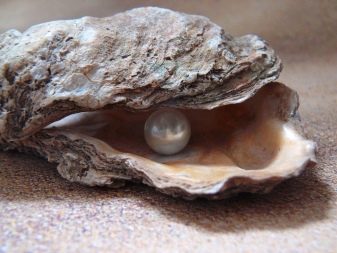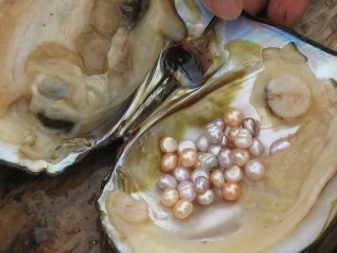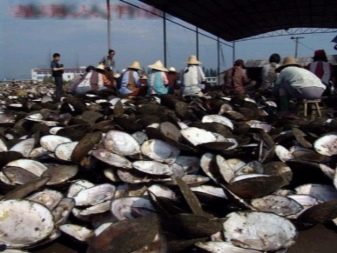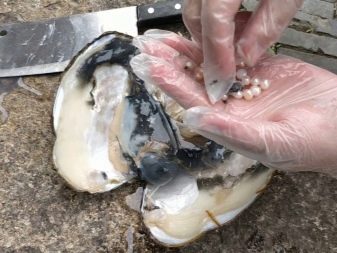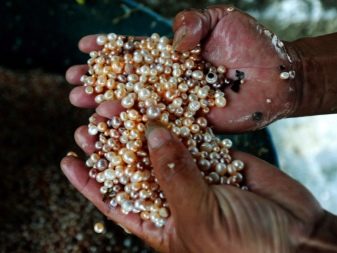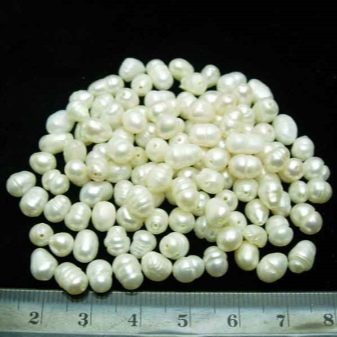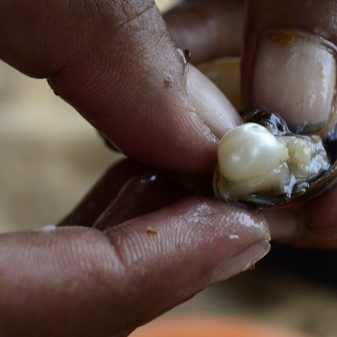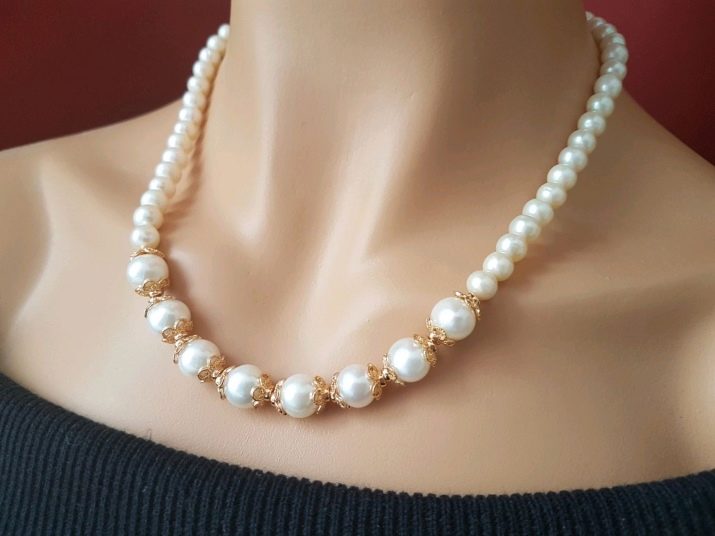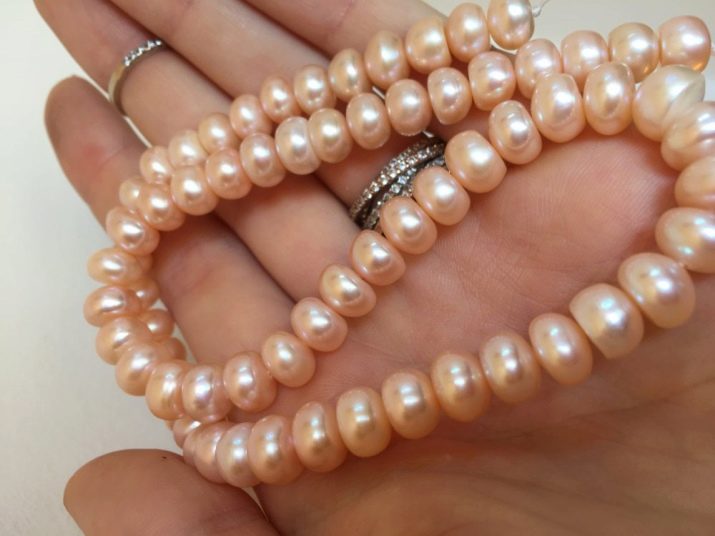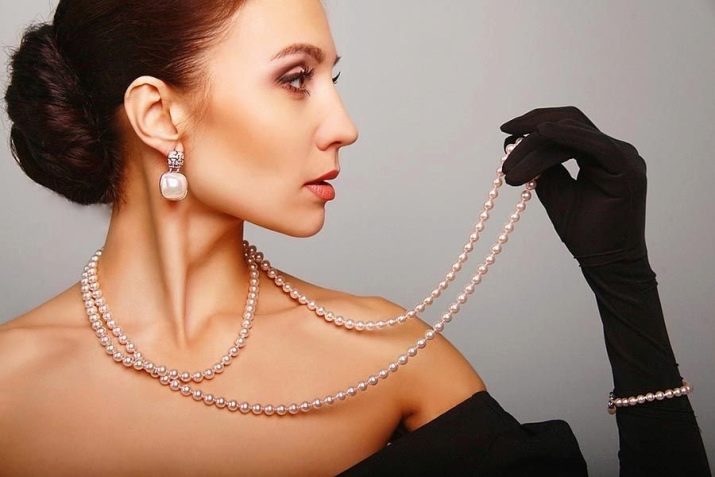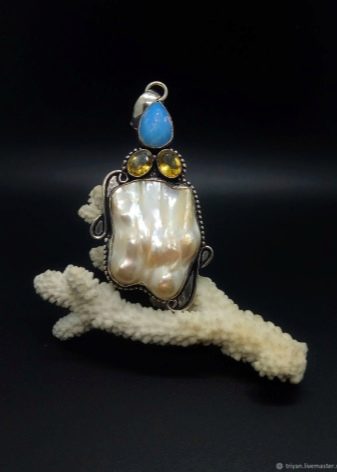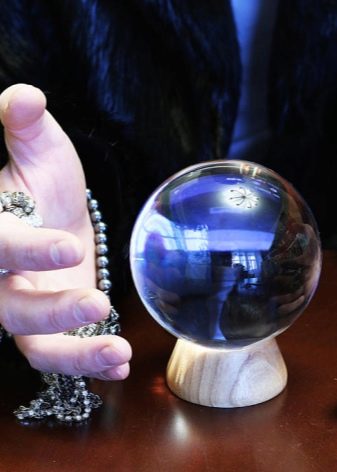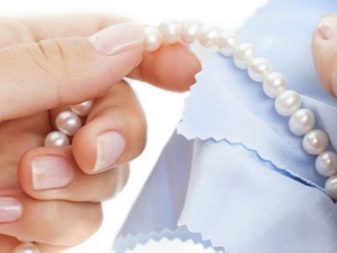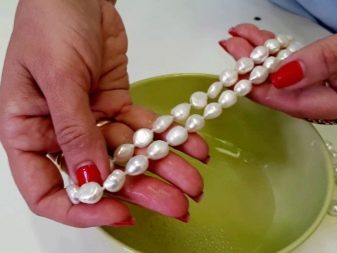River pearls: features, properties and differences from the sea
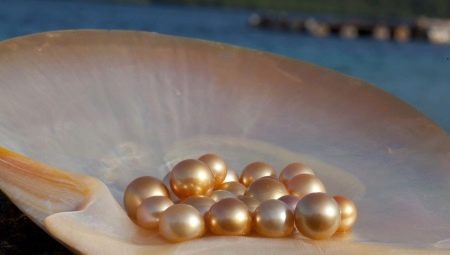
Pearl jewelry is quite popular among women and girls of any age. However, not all women know that in nature there are different types of this stone: river and sea. What are the peculiarities of a river pearl, how is it formed, how does a sea species differ from a river one, what are some subspecies of river pearls? Answers to these and many other questions can be found in our article.
What it is?
A freshwater pearl is a pearl-colored gemstone that has a small size. These beads are completely natural, as man is not involved in their creation (however, to date, special pearl farms have been created). Pearl beads are formed inside the shells of mollusks.
Notable is the fact that mollusks grow precious and beloved by many stone from simple sand. In one shell there can be several pearls at once.
In nature, it is quite difficult to find several identical pearls, because each of them is unique in its external properties. The color, shape, and some other characteristics of the pearls are completely dependent on the particular clam in the shell of which they were grown. That is why stones can be found on sale, which have an ideal form and proportions, but you can find specimens that are not very aesthetically attractive.
How is it formed and where is it mined?
Pearl beads are formed inside the clam shell due to the ingress of grains of sand. Due to the fact that there is a huge number of nerve endings in the body of the aquatic inhabitant, he immediately senses a foreign body, therefore the response follows immediately. As a protective reaction to the ingestion of a foreign element inside the shell, the oyster secretes nacre, with which a grain of sand grows. The term of formation of the gemstone is from 3 to 12 years. This period may depend on a large number of factors: the age and type of the mollusk, the state of the environment and much more.
In cases where pearls are grown independently, the foreign element in the oyster shell is placed on purpose. As for the extraction of pearl beads, it is carried out in several countries of the world: in Russia, the United States of America, Germany, and China.
To get pearls, it is necessary to collect mollusks and open their shells.
Varieties
In nature, there are only 2 varieties of river pearls. They differ in their mode of cultivation.
- The first type is formed randomly, without human intervention. There are enormous difficulties with regard to the extraction of such a stone. Firstly, it is quite difficult to detect, because the only indirect sign of the presence of pearls is a large accumulation of freshwater oysters. In addition, it is impossible not to note the fact that the extraction of such gems is associated with large material and time costs.
- The second variety of freshwater pearls is cultured beads. These are the stones that are grown by people through artificial means, and are presented in large quantities on the jewelry market today.
In addition, pearls can be divided into categories depending on the color in which the beads are colored: white, cream, pinkish, etc.
What is different from the sea pearls?
As mentioned above, in nature there are 2 types of pearls: sea and river. Both those and other stones are highly valued by jewelers and are used to make various ornaments. Despite the large number of identical characteristics, sea and river pearls have pronounced differences. Let's get acquainted with them in more detail.
- The first thing to say about the intensity of the brilliance of pearls. Sea specimens shine much better and brighter. Against the background of sea representatives, river stones lose - they look more dim.
- The shape of sea and river pearls is also different. Of course, there are exceptions, however, mostly freshwater specimens have a more elongated, oval shape, and the sea stones opposite are rounded.
- The color characteristics of the 2 types of beads are also significantly different. The range of shades of river pearls is rather limited and varies from white to milky shades. At the same time, unusual pearls can be found in the depths of the sea, which can be painted in the brightest shades (for example, black or pink).
- However, there are some indicators for which the sea pearl loses much to the river pearl. These characteristics include, above all, durability. So, over time, those stones that were found in seawater can lose their luster and gloss. River specimens retain the attractiveness of their appearance much longer. This difference is explained by the different thickness of the nacre layer on the stones.
- In addition, it is impossible not to note the differencethat in the shell of one river mollusk you can find from 10 or more pearls, and in the shell of the sea - only 1.
Based on all the above characteristics, it is quite simple to conclude that freshwater pearls are cheaper than sea ones. That is why this stone is preferred by many of the fair sex.
Classic pearl beads look equally attractive, no matter what kind of pearls they are made from, but the price of the river stone will be much lower.
How to distinguish from fakes?
Due to the fact that pearl jewelry is quite popular in the jewelry market, many scammers and unscrupulous sellers are trying to give out other, cheaper materials for pearls. To distinguish natural stone from not present, you must follow a few simple rules.
- First of all, it should be remembered that no matter how good the fake is, it will weigh less than natural stone in any case. Therefore, if in front of you there are several identical in appearance but different in weight ornaments, then give preference to the heavier variant.
- Natural pearls are stones that are always cool to the touch. If the seller has suggested that you familiarize yourself with the jewelry and touch it, please note that the stones that will be warm are not real.
- Natural stone has special mechanical and physical properties, which are primarily associated with its internal structure. So, if two natural pearls rub against each other, then they will not appear any marks or scratches. In addition, if you throw a pearl on a hard surface, it should definitely bounce off of it.
- Also, when buying carefully inspect the appearance of the stone. It must be whole and have a homogeneous structure. If irregularities in coloring or scuffing are noticeable, then you are offered a fake, so it is better to abandon any transactions with such a seller.
Application
River pearls are widely used in various spheres of human life.First of all, this stone is used in jewelry, which can be worn to all the fair sex, regardless of age, body type, etc. It is believed that a thin string of pearls can give nobility and status to the image.
In addition, it is believed that pearls have a large list of magical and healing properties. In this regard, various amulets and talismans are often made of stone, which have healing and magical properties. Many psychics and people with supernatural abilities use pearls in their rituals.
Storage and care
In order to extend the life of the pearl and maintain the attractive appearance of the stone for a long time, you must follow its simple rules. storage and maintenance.
- First of all, it is important to pay attention to the storage conditions of pearl jewelry (especially if you do not use them every day). Experts recommend storing the river stone in a separate box or box. Thus, the stone will be in the dark and, as a result, will be protected from a large number of external negative influences. However, one box is not enough. Before placing the pearl jewelry into any container, it should be carefully packed in a fabric bag (it can be made of linen, silk or satin).
- In addition, in order to preserve the brilliance of a natural gem, it is necessary to take care of its timely cleaning. In no case in the course of this procedure can not use chemical components or aggressive detergent solutions, as they can only harm the decoration. The ideal solution for cleaning pearls from dust and dirt is soap.
Wipe the beads with a soft delicate cloth. Thus, to clean the pearl jewelry at home is quite simple.
On the history and origin of pearls, see below.
